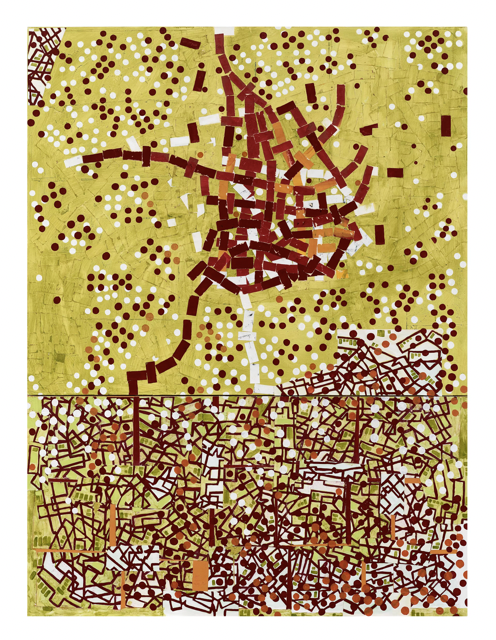Free and open to the public. Thursday to Sunday, 10AM—6PM.
150 Camp St, San Antonio, TX
Free and open to the public. Thursday to Sunday, 10AM—6PM.
150 Camp St, San Antonio, TX

We had the pleasure of doing a Q&A with Rick Lowe in which he shared information about his practice and his recent painting Untitled, 2021, our newest addition to the collection, and much more.
In this series, you highlight the game of dominoes. For you, this game and the shapes that form its play are a source of inspiration and a signifier of the political, social and economic issues faced by the Black community. Can you tell us more about those connections and what you find so visually appealing about the game?
In America, almost anything a Black person has a political, social and economic impact. For example, just walking through a park eating skittles can be perceived as threatening and cause a loss of life. Black people understand this. So political, social and economic issues naturally find their way into the most uncomplicated games. In many instances, much of the pressures of life are played out at the domino table. At times, the psychological warfare employed is preparation for the harness that life offers outside of the game. In some circles, the domino table is called the “humility table.” I became interested in the game when I understood how the act of playing dominoes for many went way beyond a game.
You often reference mapping when you speak about this series. Can you tell us more about that connection and how it relates to your work in general?
During the late 1990s, I was trying to understand how real estate works, how neighborhoods develop (or don’t develop), and how resources flow around the city. In our community space at Project Row Houses, we had maps about land use, historical maps, land ownership, etc. I was as much fascinated with the aesthetics of the maps as I was with the information they provided. So, I had an interest in maps. After playing dominoes for some years, I became fascinated with the patterns made by each game. I first started photographing them. Then later tracing them. It became interesting to explore what happens if the tracings were layered upon one another. This layering revealed the presence of mapping.
You trained as a studio-based painter making representational, politically engaged images. But, for over 20 years, you re-focused your efforts and transitioned into a social practice, founding and leading Project Row Houses, earning you, among many other accolades, a MacArthur “genius” Award. What prompted you to shift your focus back to painting?
While I enjoyed the formal aspects of studio painting, I mainly saw it in service to my political activism and was concerned about how my work could affect political change. I pushed my work as far as I could into political action as a way of shifting the function or role that art plays in society. At a certain point, I didn’t feel that the traditional form of painting could produce the kind of change I was trying to achieve. When I discovered Joseph Beuys‘ concept of social sculpture, I found a form of art that merged my interest in art and activism and that took me away from painting. While I didn’t paint seriously for over 25 years, I’ve always seen the world through the lens of a painter. It has always been under the surface. So when I started doing the domino drawings, it soon led me back to painting.
This painting incorporates a unique color palette with a vivid yellow and red and touches of green, a color I see more and more in your work. How did you land on this combination of colors? Do they represent something in particular to you?
I was formally trained as a landscape painter. So green is a familiar color for me. I love playing with the many shades of greens. But I often find myself challenged by what could be the seductive nature of green, so I try to use it in unsuspecting ways.
What projects do you have coming up?
Currently, I am included in Black Wall Street Journey at SMART Museum Chicago, Greenwood Art Project in Tulsa and most recently in Social Works at Gagosian.